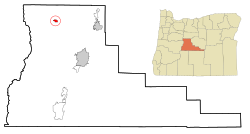First European settlements
The first notable European presence in the area was the construction of Camp Polk, which existed from September 1865 to May 1866, just 3 miles away from the current location of the town. After the site was abbandoned, in 1870, Samuel M. Hindman, was the first to settle the area properly, even building a shop and a post office. [7]
In 1888 the post office was relocated to the John J. Smith Store, which was located three miles south of Camp Polk. The name for the rebranding of the post office was the "Three Sisters". [7] The name's origin is still quite uncertain, however according to a theory, the mountains that inspired the name were named in the 1840s by members of a Methodist mission based in Salem, [9] hinting at an alleged earlier European presence. However due to unknown reasons, the postal authorities shortened it to "Sisters". [7]
It seems that the early growth of the city can be attributed to various factors, such as sheep traffic over the Santiam wagon road, [9] and its location at the intersection of the McKenzie and Santiam roads. [7]
Recent history
20 years after the opening of the local post office, on July 10, 1901, two enterprising brothers, Alex and Robert Smith, officially platted the City of Sisters. [7]
By the turn of the century, cattle raising had replaced sheep herding as the main industry in the region, leading to the town needing to re-invent itself. The town started to focus on cattle-raising, primarily due to the contribution of the local Black Butte Land & Livestock Company. [9]
After a while, the city re-invented its economy once again, now looking at the logging industry, with the building of the Duckett & Spoo mill in 1914. It is worth noting though that this industry, whilst not as prosperous earlier on, also existed as far back as the 1890s in the area. [9]
Between 1923 and 1924, two fires hit the town, almost destroying it. The event was so traumatic to inspire writer Raymond R. Hatton recounted the terrible events in his book, “Oregon’s Sisters Country”: [8] [10]
“On May 11, 1923, fire broke out in an untenanted garage, spread rapidly and leveled one entire block of town … The fire destroyed 10 buildings — some businesses, some residences — within 15 minutes after the first alarm.... The next year, late in the afternoon on September 11, fire once again broke out and raced through parts of Sisters,”
— Raymond R. Hatton, Oregon's Sisters Country
Records from the time seem to indicate that several hundred people from the area gathered to watch the blaze, which could be seen from neighbouring towns and nearby areas. [9]
However, despite the setback caused by the fires, the town rebuilt, [8] and grew. [7]
By the 1930s, Sisters was starting to be known locally as a lumber-producing town and was incorporated in 1946. Everything seemed to be fine, and the population had reached its historic peak of 500 inhabitants, however, lumber production fell off and in 1963 the last mill in Sisters was closed. This led to the demographic of the city to drastically fall. [7]
However in the 70s, the town would have a turn for the better when Brooks Resources, the developers of Black Butte Ranch, decided they needed a place for the residents of the nascent resort which they planned to construct, to shop. [8]
By 1974, the Sisters Area Chamber of Commerce was formed, and the development of the local infrastructures and roads led to the city to develop its own stable economy and to prevent further demographic losses. [7]
The town took serious blows from the 2008 economic crisis and the coronavirus pandemic which restricted economic activity (by limiting tourism) and also put the life of the local population at risk. [8]








